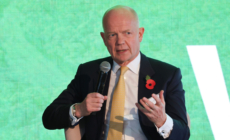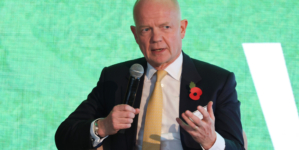-
Bitcoin-mining computers among loot stolen by international theft crew - 21 mins ago
-
Donald Trump Lacking ‘Strength’ in Russia-Ukraine Talks: British Ex-FM - 34 mins ago
-
4 Major Endorsements Jolt N.Y.C. Mayor’s Race (None Went to Cuomo) - 46 mins ago
-
High hopes but long odds against a GOP governor in California - about 1 hour ago
-
Florida Could Take Tourism Money to Pay for Tax Refunds - about 1 hour ago
-
Vance Outlines U.S. Plan for Ukraine That Sharply Favors Russia - about 1 hour ago
-
John Cena and Idris Elba Reunite in Buddy Action Comedy ‘Heads of State’ - 2 hours ago
-
‘It is time for you to leave’: DHS mistakenly notifies U.S. citizens - 2 hours ago
-
Durbin, No. 2 Senate Democrat, to Retire After 44 Years in Congress - 2 hours ago
-
Enormous Russian Arms Depot Explodes, Emptying Nearby Villages - 2 hours ago
Funding cuts hit Head Start, imperiling child care in California
Since President Trump took office in January, Head Start centers have been unnerved by an escalating series of threats, including, most recently, total annihilation.
An end to the historic federal early childhood program would leave about 800,000 low-income children across the U.S. without access to child care, medical screenings, and nutritious food — including about 80,000 children from birth to age 5 in California.
First came the executive order to temporarily freeze all federal financial aid in January, when Head Start staff suddenly couldn’t access the funds they had been promised. Although the memo was rescinded days later, dozens of centers reported that they couldn’t access their funds for weeks; unable to meet payroll, some were forced to shutter for a few days.
On Feb. 14, scores of federal staffers were laid off at Health and Human Services’ Office of Head Start in Washington, D.C. And on April 1st, the administration announced that five of the 12 regional offices managing relationships with Head Start grantees would be closed immediately and all employees laid off, including Region 9, which cover four states, including California.

A teacher reads a child a book at Pacific Clinics Head Start in Pasadena.
Now the very existence of the program is imperiled: A leaked draft of the administration’s budget proposal for the Department of Health and Human Services would defund Head Start and phase the program out by 2026, a move that would slash a critical safety net for families who otherwise could not afford child care and the other comprehensive services they receive.
In addition, the draft budget calls for terminating an array of HHS initiatives dedicated to helping families with newborns and young children. Programs slated for elimination include Healthy Start, which is dedicated to healthy pregnancies and births, newborn screenings for heritable disorders and hearing, infant and early childhood mental health, childhood lead poisoning, family planning and drowning prevention.
While the document does not represent a final decision, it will serve as a guidepost for Trump’s 2026 budget, which must then be approved by Congress. The White House referred The Times to OMB for comment, where the communications director, Rachel Cauley, did not deny the contents of the memo. “No final funding decisions have been made,” Cauley said.
The plan, if approved, would represent a fundamental retraction of the federal government’s longtime role in helping families with young children have a healthy start in the critical early years of life, said Elisabeth Wright Burak, who studies child health policy at the Georgetown University McCourt School of Public Policy’s Center for Children and Families.
“That’s really unprecedented damage to the social safety net for families,” said Burak. Alongside the proposed mass cuts to Medicaid, the federal-state health insurance program for low-income Americans, she said, “I would worry it would do irreparable damage.”

Jessica Lepe Rodriguez, left, and Karen Locken, right, dance with children in the Early Head Start program at Pacific Clinics Early Head Start Center in Pasadena. Pacific Clinics in L.A. County has seven centers serving about 500 kids.
The proposed actions are also antithetical to Trump’s campaign promise to be pro-family, and Vice President JD Vance’s pledge to shore up the nation’s fragile and high-cost child-care industry, especially the proposal to eliminate Head Start, early childhood experts said.
“It’s just terrifying on every level,” said Stacey Scarborough, who runs the Early Head Start program at Venice Family Clinic, which serves 376 pregnant women, infants and toddlers, and was the past president of the Head Start California Association. “It’s terrifying for the community, it’s terrifying for the staff, it’s terrifying for the families, and it’s just terrifying for the future.”
Engage with our community-funded journalism as we delve into child care, transitional kindergarten, health and other issues affecting children from birth through age 5.
On Friday, Venice Family Clinic sent out an email to their parents, letting them know of the possible closures. For families living on the brink, a this news is “very scary,” said Scarborough: Missing work could cost them their job, and eventually their home.
The email asks the families to start writing letters, sharing their stories, and calling their members of Congress to plead for continued funding. Head Start centers have fought for their lives in the past — including against a plan to block grant the program in the 1990s — and they know how to fight, said Scarborough. “I don’t know if that’s really going to work. But it’s what we have to do.”
An existential threat from Washington

A 1965 image of a Head Start summer program in Washington.
(Sam Myers/Associated Press)
Head Start was founded in 1965 as part of President Lyndon B. Johnson’s “War on Poverty,” and has served more than 40 million children over the past six decades. The program — which is celebrating its 60th birthday this year — was set to receive more than $12 billion in funding for the current year. California alone was slated to receive about $1.6 billion in grants to centers that employ 26,000 workers.
The program has came under attack several times over the decades, most recently during the presidential election last year, when Project 2025 called for the program to be terminated on the grounds that it is “fraught with scandal and abuse” and has “little or no long-term academic value for children.”
Russell Vought, one of Project 2025’s principle architects, now serves as the director of the Office of Management and Budget, which authored the budget draft.
“This elimination is consistent with the Administration’s goals of returning education to the States and increasing parental choice,” OMB wrote in the draft budget, which is the product of discussions between OMB and HHS. “The Federal government should not be in the business of mandating curriculum, locations, and performance standards for any form of education.”
The Head Start program, however, does not mandate a particular curriculum to centers, and it is one of several child-care programs offered to low-income families. In California, families can also access state preschools or vouchers for a program of their choosing, which includes family child-care homes and money to help pay for care from a family member, friend or neighbor.
Decades of research point to the positive impacts of Head Start on children, including improved cognitive and social-emotional development, though a federal study found that some of these effects fade out over time.
Bipartisan support for Head Start may be wavering
Head Start has had longtime support from Democrats and Republicans in Congress. Last year, 33 House Republicans signed a letter urging the Appropriations committee “to fund Head Start at the highest level the Subcommittee deems possible.” And many Republican members announce Head Start grants to their district as a point of pride in press releases, including Rep. David Valadao, whose San Joaquin Valley district received $50.3 million in funding for the 2023-2024 school year.
“The effort right now is to give those bipartisan members — including many Republican members — the tools they need to push back,” said Sarah Rittling, executive director of the nonpartisan First Five Years Fund, which lobbies Congress on early childhood education.
The stark political divide and vast appetite for cost reduction this year in Washington, however, mean it’s unclear how many Republicans will be willing to pledge their support for Head Start.
Trump has targeted Head Start’s funding before, albeit unsuccessfully. In his 2018 presidential budget, he proposed to cut funding to the Head Start program by $85 million and by $29 billion in 2019; neither proposal passed. Instead, Congress decided to increase funding to the program in both budget years.
This time, the threats are far more serious. “We’ve never had the adversary in the White House that we have today,” said Ed Condon, executive director of the Region 9 Head Start Association, which represents four states, including California.
No members of the California Republican delegation to the House signed last year’s letter in support of Head Start.

Viviana Banuelos, teacher, left, plays with a child in the Early Head Start program in Pasadena. Head Start serves 800,000 low-income children across the country, including 75,000 in California.
“Especially given the dire financial condition of the federal government, the enormous cost of this program and its questionable effectiveness, it ought to be suspended until rigorously reviewed and reauthorized by Congress,” Rep. Tom McClintock (R-Elk Grove) said in a statement to The Times this week.
The Head Start program has long been a target among conservative thinkers at the Heritage Foundation and the Cato Institute, who say the federal government should not be involved in child-care programming.
“The country is just too big and too diverse for bureaucrats in Washington, D.C., to really know what education should look like in random towns or cities around America,” said Colleen Hroncich, an education policy analyst at Cato, who points to federal research that found the positive effects of the Head Start program fade out by third grade.
“Something can sound really nice as a concept, but if it doesn’t actually do what it was aiming to do, then people should reevaluate it,” she said.
Head Start should be phased out slowly, she said, to allow states and churches to fill the affordable child-care gap left behind.
Many Head Start programs say delays in payments have grown worse since the federal workers in the regional offices were laid off.
Administrators of programs that are supposed to begin their next fiscal year May 1 say they have not received the next round of funding.
So far this year, there has been a nearly $1-billion shortfall in Head Start funding compared to the same period in 2024, according to an Associated Press report.
“What I worry about with this administration is it’s like a game of whack-a-mole, said Katie Hamm, who served as the Deputy Assistant Secretary for Early Childhood Development during the Biden Administration. “There’s a funding issue on Monday, and then some programs close, and then the funding starts to flow, and then there’s another issue … at some point, this death by 1000 cuts will be effective.”
The impact on child care in California

Jessica Lepe Rodriguez reads to children in the Early Head Start program at Pacific Clinics Early Head Start Center in Pasadena.
To be eligible for the Head Start program, families must earn less than the federal poverty level — $26,650 dollars per year for a family of three — or be homeless, disabled or part of the foster system, making them among the most vulnerable in the state.
The program has been a lifeline for Patricia Palafox, whose 2-year-old daughter Ennovy is currently enrolled in the Early Head Start program at Pacific Clinics Head Start in Pasadena, and whose 6-year-old son also attended the program. “As a single mom, I don’t have anyone to take care of them if I didn’t have this.”
The program not only provides the child care she needs to go to work full time and support her family, but also gives her daughter diapers and healthy meals. Because of Head Start, she said, her daughter can count in English and Spanish, excitedly sings songs like “Happy Birthday” and interacts with other kids.
If the program shuts down, Palafox said it will upend her daughter’s learning — and their lives. And it would come after they already faced disruption in January after the Eaton fire burned down Pacific Clinics’ Early Head Start location in Altadena, moving her daughter to the one she attends now.
Jessica Lepe Rodriguez is a single mother who depends on the program not only for child care, but also for her income as one of the many Head Start parents who also serve as a classroom aide. If the Pacific Clinics Head Start program where she works closes, she’d likely have to move in with family to stay afloat.
Pacific Clinics Head Start, which serves 500 children, is focused on turning the skills they’ve honed to advocate for their families toward advocating for the program’s very survival.
“These are young families fighting so many battles trying to work and find transportation and housing and buy food. They’re up against so much,” said Nina Paddock, an administrator at Pacific Clinics Head Start. “That’s what keeps me up, but it’s also what keeps me doing it.”
This article is part of The Times’ early childhood education initiative, focusing on the learning and development of California children from birth to age 5. For more information about the initiative and its philanthropic funders, go to latimes.com/earlyed.
Source link















